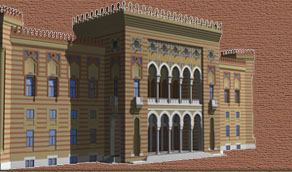
Sarajevo City Hall
t h e n a n d n o w| About City Hall | ||
| Photos | ||
| Virtual model |
Historically, the object’s creation is linked to the year 1890, when the city of Sarajevo showed signs of great progress and prosperous future, which yielded the need for a new city hall. Synchronously with the project of Hapsana (Beledija) in the west part of Mustafa-pasha’s meydan, which was made in the form of a well-proportioned palace, architect Karlo Parik designed the City Hall as well. The location of the building itself, dictated it’s basic shape – that of an equilateral triangle. The control of Miljacka’s flow was at the time already defined, so Parik designed the City Hall to face the river. Mustafa-pasha’s meydan would be connected with the center of Caršija by a new street (in the direction of southeast-northwest), built on 1869 due to personal involvement of Topal Osman-pasha vezir. The street was lined with stores and craft workshops.
By placing the building of Beledije at the western side of the triangle, as the beginning of the new architectural district spanning westward, Parik had created a plot in the shape of an equilateral triangle. The fact that the axes of the main entrance to Beledija and the City Hall’s west entrance are ideally matched corroborates the fact that the two buildings were designed at the same time.
The City Hall’s design bears characteristics of a pseudo-Moorish architecture, whose mastership Parik demonstrated in building the Sheriat judicial school of Sarajevo in 1889. Despite this, the project was not accepted, and architect Aleksandar Wittek was instead hired. He worked on the project from 1892 to 1893. Studying the architecture of Islamic monumental buildings, Wittek traveled to Cairo on two occasions, but didn’t finish the project due to illness.
Ciril M. Ivekovic took over the project and following Wittek’s designs, with small adjustments of aesthetic nature, completed it in 1894.
The work on the City Hall was finalized in 1896, when the building was officially opened as part of the preparations for arrival of the ruler Franjo Josip in 1910.
In 1951, the City Hall building became home to the National and University Library of Bosnia-Herzegovina, which was the center of University studies and one of the wealthier libraries in the region for a long time.
The City Hall was completely destroyed in the last aggression on Bosnia-Herzegovina. A heavy artillery attack on the building caused a fire in the night of 25th to 26th of August of 1992 in which almost all of the books and manuscripts perished. The building’s frame was weakened and all of its wiring and the roof’s construction were destroyed. In spite of such bad condition it withstood the elements for four years when work began on preservation of its remains. Today, the building still stands in its preserved state, waiting for “its savior”.